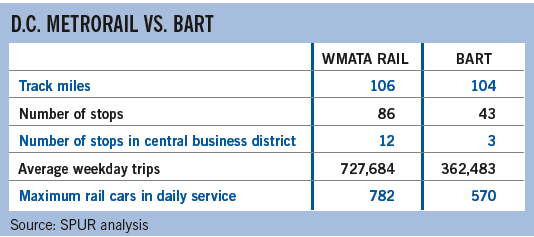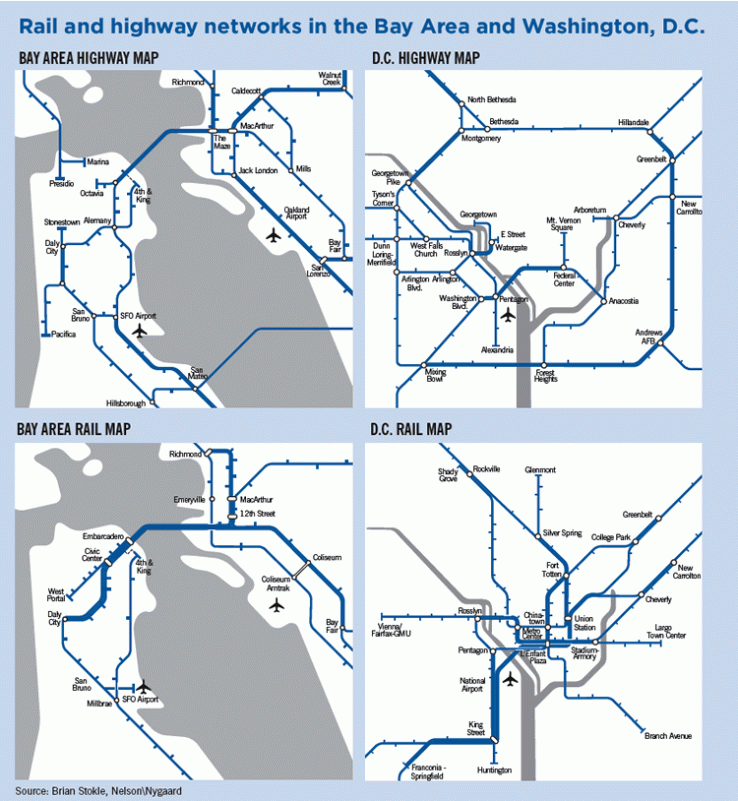But that’s where the similarities end. Metrorail has more than 700,000 riders per day while BART has fewer than 400,000: it’s clear WMATA has achieved a level of usability that BART has not.

Why the difference? For starters, Metrorail does a better job of getting people to and from D.C.’s downtown area. With 86 stations, it has twice as many stops as BART (at 43) — Metrorail stations are also better situated, in more easily accessible locations. In general, Metrorail has twice as many stops as BART; in D.C.’s central business district, it has nearly four times as many. Another potential reason, geographical rather than geological, is that BART had to work around the San Francisco Bay, a natural barrier far larger than the Potomac River.
Perhaps most significantly, BART stations are built where it has proven politically and financially easiest to put them. The clearest evidence of this lies in the battles avoided in putting the stations where they are: in large part, the stations are located on rights-of-way already controlled by Caltrans, which had a substantial hand in developing the project. Instead of studying where people want to go and building a system that gets individuals as close as possible to those locations, the majority of the stops outside San Francisco follow existing rail and highway rights of way (with the exceptions of the downtown Oakland and Berkeley stops — in the latter case, the City of Berkeley had to raise funds to have the stops located closer to the heart of the city, rather than along the highway one mile west). BART was built as an imitator of the freeway because it was the easier path to take, and in so doing avoided controversy but left the system uncompetitive with the freeways ringing the Bay. This tactic is not surprising given the fragile nature of the inter-county pact, requiring state approval, that went into forming the BART system. The San Francisco Bay Area Rapid Transit District formed in 1957 with representatives from five counties, but by 1962, two of the five — Marin and San Mateo — had withdrawn from the project.
All of the planning of the Metrorail system, and part of the initial implementation, was conducted by a federal agency, the National Capital Transportation Agency, before Washington, D.C. had been granted home rule. The NCTA was given relative autonomy by the federal government and the voters of Virginia and Maryland (though not of powerless Washington). Instead of answering to several layers of elected local and state representatives who themselves answered to an electorate perhaps uneasy about an experimental transit system, when it came to plans within D.C., the designers of Metrorail answered to federal officials who ultimately answered to constituents perhaps far away or relatively close, but definitively not in the District of Columbia. There was far less need to compromise the vision of the best transit system for the region it served.
Washington has, since then, been granted home rule, and the Metrorail system has expanded into states that have had local governance since before the founding of the United States, and are unlikely to be cowed by the will of WMATA. However, it was the substantial stop density planned during the early- and mid-20th century that has brought about the success of the Metrorail system. And the WMATA Board of Directors, composed of appointees from the states of Maryland and Virginia and the District of Columbia, are far more insulated from political pressure and public opinion than the BART Board of Directors, who are directly elected through local district elections.
These lessons are still relevant today. In planning a BART extension in Livermore, for instance, a small but vocal group has tried pressuring BART to abandon its plans to put a station in the downtown area, in favor of a freeway alignment.
But, BART planners are realizing that the tips of its five lines are not the only places where improvements can be made. BART needs to carefully analyze where it is possible to build in-fill stations to help more people arrive in city centers and downtown destinations. This would involve political will, but BART can learn from WMATA that such investments lead to lasting success.

